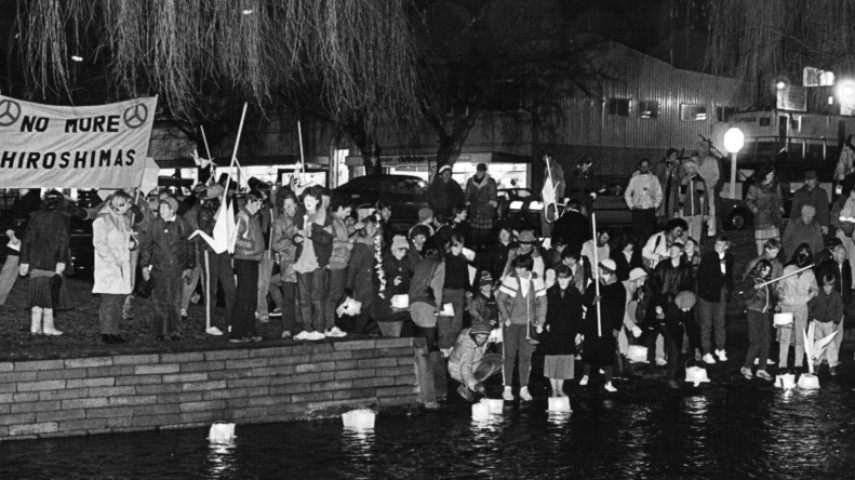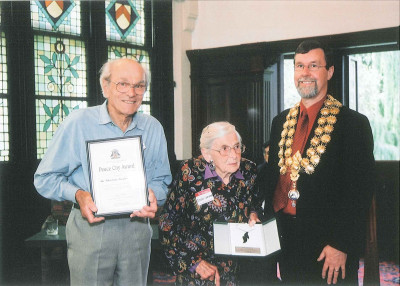Christchurch's history and connection to the peace movement were instrumental in the city becoming New Zealand's first Peace City in 2002.

Lantern Ceremony, Victoria Square, August 1986. Credit: Christchurch Press.
Ōtautahi/Christchurch became New Zealand’s first Peace City in May 2002, also marking the 20th anniversary as the country’s first Nuclear Free City in March 1982.
It consolidated Christchurch’s long peace history and demonstrated our city's commitment to actively foster a peaceful future through a range of community initiatives.
These initiatives were based on recommendations from the experts on the UN Study on Disarmament and Non-Proliferation Education, including local peace and disarmament campaigner Dr Kate Dewes ONZM.
The study was adopted unanimously by the UN General Assembly in 2002, which encouraged municipal leaders working with citizen groups to establish peace cities, “through, for example, the creation of peace museums, peace parks, websites and the production of booklets on peacemakers and peacemaking.”
Peace proposals adopted by the Christchurch City Council include establishing a World Peace Bell, gifting a Peace Sculpture to the city of Nagasaki, granting Peace Awards, exhibiting material at the Canterbury Museum about Hiroshima and Nagasaki, Mahatma Gandhi and New Zealand’s nuclear-free legislation, creating a peace collection in the Christchurch library, sourcing memorabilia for the museum and peace archives for the Macmillan Brown Library, and creating online content documenting the city’s rich peace heritage.

United Nations Group of Governmental Experts on Disarmament and Non Proliferation Education, 2002. Dr Kate Dewes front left.
Aotearoa/New Zealand has a long tradition of peacemaking among both Māori and Pākehā. As the first people of the land, Māori brought with them, and applied, the principles of Rongomaraeroa – the Mauri (life force) of Peace – laying the foundations for peace in our country.
Throughout its history, Aotearoa/New Zealand has produced numerous prominent peacemakers, many of whom are documented on the Disarmament and Security Centre’s online archive(external link).
Some of these figures were integral to New Zealand becoming nuclear-free in 1987, taking a case to the International Court of Justice on the legality of nuclear weapons(external link) in the 1990s, and educating the public on the importance of peace, non-violence and disarmament.
At the local level, Canterbury has been the historical birthplace of many peace-related movements. Honouring this rich heritage is an important part of Christchurch’s identity as a city committed to peace, as well as other New Zealand cities such as Wellington and Auckland.

Ada Wells, Christchurch City Councillor 1917 to 1919
The anti-militarist movement began in Christchurch in 1910. This was followed by hundreds of Canterbury men being imprisoned for conscientiously objecting to conscription during World War I.
In 2016 the University of Canterbury and the Disarmament and Security Centre(external link) created the Voices Against War(external link) website documenting stories about Canterbury men and women who spoke out against war and military conscription.
It highlights the stories of some courageous individuals who became political prisoners during this tumultuous period. Some served time in the old Lyttelton jail, some in the new prison at Paparua and others endured military detention in Fort Jervois on Ripapa Island.
The labour movement was almost wholly anti-militarist and some of these men were jailed for breaching the government regulations that said it was sedition to speak out against conscription or war.
Women were not directly involved in compulsory military training or conscription, but some were involved in the anti-militarist organisations, including the first female Christchurch City Councillor Ada Wells(external link), who was elected on a Peace platform.

Hiroshima and Nagasaki Day March led by Elsie Locke, Worcester Blvd, early 1960s
In August 1945, only a few days after the atomic bombings of Hiroshima and Nagasaki, Philosopher Karl Popper – then a lecturer at the University of Canterbury – gave what was possibly the world’s first anti-nuclear lecture.
Addressing a packed auditorium, he uttered the words "When the first atomic bomb exploded, the world as we have known it came, I believe, to an end."
Two years later, in 1947, Christchurch witnessed its first anti-nuclear march on the anniversary of the atomic bombings. This marked the beginning of the anti-nuclear movement in the city, and in 196,0 the New Zealand Campaign for Nuclear Disarmament (CND) was headquartered in Christchurch with Mary Woodward and Elsie Locke in key leadership roles.
In March 1982, Christchurch became the first New Zealand city to declare itself a Nuclear Weapon Free Zone.
The NZ Nuclear Free Zone Committee,(external link) led by Larry Ross, organised this local-level action nationally, which eventually led to the passing of the New Zealand Nuclear Free Zone, Disarmament and Arms Control Act in 1987(external link).
Christchurch has continued to mark significant anniversaries of this Act(external link), and the 1996 World Court Advisory Opinion on nuclear weapons(external link).
Peace people

Harold Evans and Kate Dewes handing over Christchurch Declarations of Public Conscience to Cabinet Minister Philip Burdon in 1992
In 1986 retired Christchurch district court magistrate Harold Evans and other local residents initiated what would become The World Court Project.
Initially led mainly by New Zealanders, this civil society campaign aimed to have the International Court of Justice (the highest legal branch of the United Nations, also known as the World Court) give an advisory opinion on the legal status of nuclear weapons.
Millions of Declarations of Public Conscience from around the world were submitted to the Court as evidence. In 1996, the Court announced its landmark ruling stating that “[The] threat or use of nuclear weapons would generally be contrary to the rules of international law applicable in armed conflict, and in particular the principles and rules of humanitarian law.”
Ever since 1996, the New Zealand government has linked this important ruling to its more progressive disarmament objectives, advocating strongly for the elimination of nuclear weapons. This initiative continues to play a significant role in calling for nuclear disarmament worldwide and demonstrates the international scope of Christchurch’s peace heritage.

Mayor Lianne Dalziel unveils a commemorative seat to local peacemaker Larry Ross in 2016
Christchurch has been home to many peace people, some of whose stories are housed in the Disarmament and Security Centre’s online archive(external link), and the Macmillan Brown Library including papers from anti-nuclear campaigners Larry Ross(external link), Harold Evans, Kate Dewes and Robert Green(external link), and the Christian Pacifist movement.
Local peacemakers have been honoured through various initiatives such as: a commemorative seat honouring Larry Ross in the Botanic Gardens, a building at the University of Canterbury bearing the name of peace campaigner Elsie Locke, and a cherry tree for Mia Tay near the World Peace Bell in the Botanic Gardens.

Christian Pacifists Jack Rogers and Connie Summers were imprisoned during WWII. Connie Summers was the only woman imprisoned in NZ for sedition
In December 2002 Mayor Garry Moore presented the first eight Peace Awards to the following campaigners and groups:
Harold Evans, LLM, QSO; Larry Ross, QSM; Mia Tay; Reverend Maurice Gray MNZM; the Sumner Peace Group; Patricia Morrison; The Christian Pacifist Society and Dr Neil Cherry ONZM.
In September 2007, Dr Kate Dewes ONZM was also given the award.
Promoting peace

Annual Hiroshima and Nagasaki Commemoration at the World Peace Bell
The award-winning World Peace Bell, made from coins and medals donated by 103 countries, was unveiled in the Christchurch Botanic Gardens in 2006.
A camphor tree propagated from one of the trees that survived the atomic bombing of Nagasaki is planted nearby.
The Bell has become a focal point for gatherings to mark the anniversaries of the atomic bombings of Hiroshima and Nagasaki, the Christchurch Mosque Shootings, the UN International Day of Peace, UN Day for the Elimination of Nuclear Weapons, and other significant dates.
Each year since 1976, Christchurch has held peace week activities to commemorate the two nuclear bombings on the cities of Hiroshima (6 August) and Nagasaki (9 August). Until the Canterbury earthquakes in 2010, the annual lantern ceremony was held in Victoria Square. Since then, it has been held at the World Peace Bell.
Commemoration ceremonies are also held here and annually attended by locals and visitors, the Mayor of Christchurch, local City Councillors, Members of Parliament, and the Japanese women’s choir.
In 2017 the ceremony was filmed by a famous 88-year-old Japanese filmmaker and hibakusha (atomic-bomb survivor) Akinori Suzuki for his documentary Hiroshima All over Again about the ongoing effects of nuclear radiation on New Zealand nuclear test veterans and ordinary citizens in the Pacific Islands of Tahiti and the Marshall Islands. His film has since been shown to millions of viewers in Japan.

Unveiling the Cloak of Peace Sculpture. From left, Hon Phil Goff, Ms Sachiko Yasui (atomic bomb survivor), Dr Kate Dewes, Tomoko Maekawa and Kingsley Baird (sculptor) in Nagasaki 2006
On 21 October 2006, at the Peace Park in Nagasaki, the Hon Phil Goff, Minister for Disarmament, unveiled The Cloak of Peace – Te Korowai Rangimarie, a sculpture created by Wellington designer Kingsley Baird.
The sculpture was a gift to Nagasaki from the New Zealand government, the cities of Christchurch, Wellington, Auckland, Napier, Whakatāne and Waitakere and the Disarmament and Security Centre.
Te Korowai Rangimarie commemorates the destruction caused by the nuclear bomb that destroyed most of Nagasaki and its inhabitants in 1945.
The sculpture reflects hope and optimism for a future of peace and nuclear abolition. The shadows from the light through the kowhai flowers signify support and friendship from the people of New Zealand.
One half of a pounamu/greenstone (Ira Atua Wahine) was placed under Te Korowai Rangimarie in Nagasaki, and the other half (Ira Atua Tane) placed into the reflection pond beneath the World Peace Bell in Christchurch.
Now every time the New Zealand World Peace Bell is rung, the pounamu resonates between the two countries.

Former Mayors of Nagasaki and Christchurch, Iccho Itoh and Garry Moore
Christchurch continues its connection with Nagasaki and Hiroshima through the Mayors for Peace(external link) network.
The city has been a member of the international association since 1988.
There are currently 30 New Zealand cities out of a total of 7,902 in 163 countries and regions worldwide.
Christchurch Mayor Garry Moore served as a Vice President for the Oceania region from 2005 to 2007.

Mayor Lianne Dalziel speaks at the 20th Anniversary of the World Court Advisory Opinion, Transitional Cathedral 2016
Several major events to mark significant peace dates have been held in Christchurch, such as the 20th anniversary of the World Court's historic Advisory Opinion on nuclear weapons (July 2016), the 30th anniversary of NZ's nuclear-free legislation (June 2017), plus UN days dedicated to Peace, Non-violence and Disarmament.
Schools, community groups, and locals are encouraged to organise peace-related events or commemorations at the World Peace Bell site in the botanic gardens.
The Christchurch City Council supports many other events and cultural celebrations held by members of Christchurch’s community that contribute to peace, cultural understanding and nuclear disarmament.
Useful links
- The Disarmament and Security Centre(external link)
- Peace Stories(external link)
- Voices Against War (external link)
- The Peace Foundation(external link)
- Mayors for Peace(external link)
Further reading
- Peace People: A History of Peace Activities in New Zealand by Elsie Locke (Hazard Press, Christchurch, 1992)
- Peace Power and Politics: How New Zealand Became Nuclear Free(external link) by Maire Leadbeater
- Aotearoa/New Zealand at the World Court(external link) by Kate Dewes and Robert Green
- Road to Peace [PDF, 97 KB]
- Progressing the proposal to declare Christchurch a Peace City(external link), Report of the Strategy and Finance Committee to the Council meeting of 25 July 2002
